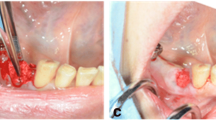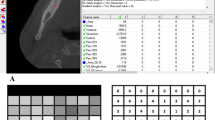Abstract
Objectives
The purpose of this study is to compare bone regeneration properties of recently available collagen-calcium phosphate (C-CP) blend as bone substitute (BS) material in oral surgery with calcium phosphate (CP) as well as collagen material (Collagen). Is C-CP better than the classic loose CP, or is it at least equally effective in the jawbone regeneration with the superiority of a coherent consistency?
Materials and methods
This study included 102 patients during 12-month follow-up. All patients underwent the following surgical procedures: sinus lift (52patients) and tooth extraction (50patients). Patients were divided into 3 groups which are as follows: experimental group with C-CP, CP and pure Collagen as control groups. Texture analysis was performed in intra-oral radiographs. Analyses were performed in the MaZda 4.6 software. Average 2444-pixel ROIs were established in the image of BS materials and normal trabecular bone for texture comparison to evaluate the jawbone regeneration process. Four features were calculated and investigated.
Results
Texture analyses revealed that all 4 features described the healing process well. Reference textural value of feature SumOfSqrs < 102.37 was soft tissue, DifEntr < 1.1 was not the bone, Entr < 2.62 was not a bone and LngREmph > 1.8 was soft tissue. For 12 months, bone regeneration was proved by 3 of 4 investigated features. Only Entr indicated to CP remnants in the ROI (p < 0.05).
Conclusions
This study proves that blended collagen-calcium phosphate as a BS material can bring satisfactory and predictable outcomes in jawbone regeneration.
Clinical relevance
Clinicians can choose a satisfactory and predictable material for bone regeneration treatment.




Similar content being viewed by others
References
Schaaf H, Lendeckel S, Howaldt HP, Streckbein P. Donor site morbidity after bone harvesting from the anterior iliac crest. Oral Surgery, Oral Med Oral Pathol Oral Radiol Endodontology. 2010;109(1):52–8. https://doi.org/10.1016/j.tripleo.2009.08.023
Kalk WWI, Raghoebar GM, Jansma JBG (1996) Morbidity from iliac crest bone harvesting. J Oral Maxillofac Surg. 54:1424–1429
Goulet JA, Senunas LE, DeSilva GL, Greenfield MLVH (1997) Autogenous iliac crest bone graft: Complications and functional assessment. Clin Orthop Relat Res. 339:76–81
Pryor LS, Gage E, Langevin C-J, Herrera F, Breithaupt AD, Gordon CR et al (2009) Review of bone substitutes. Craniomaxillofac Trauma Reconstr 2(3–4):151–160
Sakkas A, Wilde F, Heufelder M, Winter K, Schramm A. Autogenous bone grafts in oral implantology—is it still a “gold standard”? A consecutive review of 279 patients with 456 clinical procedures. Int J Implant Dent. 2017;3(1).
Sarker B, Hum J, Nazhat SN, Boccaccini AR (2015) Combining collagen and bioactive glasses for bone tissue engineering: a review. Adv Healthc Mater. 4(2):176–194
Stenzel KH, Miyata T, Rubin AL (1974) Collagen as a biomaterial. Annu Rev Biophys Bioeng. 3(0):231–253
Kozakiewicz M, Maroniak-Hoffman A, Olszycki M (2010) Comparative analysis of three bone substitute materials based on co-occurrence matrix. Dent Med Probl. 47(1):23–29
Szczypiński P, Strzelecki M MA. MaZda – a software for texture analysis. In: Proceedings of ISITC. Jeonju, Republic of Korea, p. 245–249.
Szczypiński PM, Strzelecki M, Materka A, Klepaczko A (2009) MaZda-A software package for image texture analysis. Comput Methods Programs Biomed. 94(1):66–76
Kołaciński M, Kozakiewicz M, Materka A (2015) Textural entropy as a potential feature for quantitative assessment of jaw bone healing process. Arch Med Sci. 11(1):78–84
Lurie AG (2019) Doses, benefits, safety, and risks in oral and maxillofacial diagnostic imaging. Health Phys. 116(2):163–169
Ranjanomennahary P, Ghalila SS, Malouche D, Marchadier A, Rachidi M, Benhamou C, Chappard C (2011) Comparison of radiograph-based texture analysis and bone mineral density with three-dimensional microarchitecture of trabecular bone. Med Phys. 38(1):420–428
Guo Z, Du X, Wang L, Li K, Jiao J, Guglielmi G, et al. Measurements of volumetric bone mineral density in the mandible do not predict spinal osteoporosis. Br Inst Radiol. 2019;49(3).
Suphanantachat S, Tantikul K, Tamsailom S, Kosalagood P, Nisapakultorn K, Tavedhikul K (2017) Comparison of clinical values between cone beam computed tomography and conventional intraoral radiography in periodontal and infrabony defect assessment. Dentomaxillofacial Radiol. 46(6):1–8
Aziman C, Hellén-Halme K, Shi XQ. A comparative study on image quality of two digital intraoral sensors. Dentomaxillofacial Radiol. 2019;48(7).
Buchanan A, Morales C, Looney S, Kalathingal S. Fish scale artefact on an intraoral imaging receptor. Dentomaxillofacial Radiol. 2017;46(8).
Zieliński KW, Strzelecki M (2002) Komputerowa analiza obrazu biomedycznego. Wstęp do morfometrii i patologii ilościowej. PWN, Warszawa
Yamaguchi K, Hirano T, Yoshida G, Iwasaki K (1995) Degradation-resistant character of synthetic hydroxyapatite blocks filled in bone defects. Biomaterials. 16(13):983–985
Kamitakahara M, Ohtsuki C, Miyazaki T (2008) Review paper: behavior of ceramic biomaterials derived from tricalcium phosphate in physiological condition. J Biomater Appl. 23(3):197–212
Acknowledgements
The authors thank Medif the for Collagen-CP sample delivery (www.medif.com)
Funding
This research was funded by the Medical University, grant number 503/5-061-02/503-51-001-18, 503/5-061-02/503-51-001-17, 503/5-061-02/503-51-002-18.
Author information
Authors and Affiliations
Corresponding author
Ethics declarations
Conflict of interest
The authors declare that they have no conflict of interest.
Ethical approval
This study was approved by the University Ethical Committee RNN/485/11/KB. All procedures performed in studies involving human participants were in accordance with the ethical standards of the institutional and/or national research committee and with the 1964 Helsinki declaration and its later amendments or comparable ethical standards.
Informed consent
For this type of study, formal consent is not required.
Additional information
Publisher’s note
Springer Nature remains neutral with regard to jurisdictional claims in published maps and institutional affiliations.
Rights and permissions
About this article
Cite this article
Wach, T., Kozakiewicz, M. Are recent available blended collagen-calcium phosphate better than collagen alone or crystalline calcium phosphate? Radiotextural analysis of a 1-year clinical trial. Clin Oral Invest 25, 3711–3718 (2021). https://doi.org/10.1007/s00784-020-03697-4
Received:
Accepted:
Published:
Issue Date:
DOI: https://doi.org/10.1007/s00784-020-03697-4




